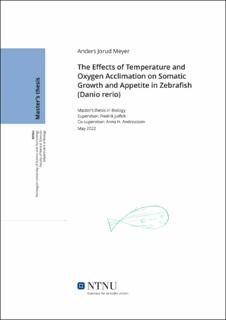| dc.contributor.advisor | Jutfelt, Fredrik | |
| dc.contributor.advisor | Andreassen, Anna H. | |
| dc.contributor.author | Meyer, Anders Jorud | |
| dc.date.accessioned | 2022-07-02T17:21:18Z | |
| dc.date.available | 2022-07-02T17:21:18Z | |
| dc.date.issued | 2022 | |
| dc.identifier | no.ntnu:inspera:104135638:15559927 | |
| dc.identifier.uri | https://hdl.handle.net/11250/3002415 | |
| dc.description.abstract | Uforutsigbare hetebølger og brå endringer i oksygenmetning blir mer og mer alminnelig i kystområder rundt omkring på Jorda. En av forutsetningen for å kunne forstå hvordan ektoterme dyr vil påvirkes av fremtidig klimaendring, er å forstå effekten av nettopp disse faktorenes påvirkning på livet i havet. En bred forståelse av disse variablene vil være til hjelp for senere å forstå endringene vi har i vente.
Under dette eksperimentet ble fisk akklimmert til ekstreme situasjoner i et forsøk på å etterligne trendene observert i det ville i dag. Eksperimentet er en mindre bit av puslespillet for å teste ”Aerobic Scope Protection Hypothesis” presentert av Jutfelt et. al. i 2019. I dette studiet ble det testet om en økt mengde tilgjengelig oksygen kan øke det metabolske vinduet hos zebrafisk (Danio rerio). Et større metabolsk vindu ville potensielt tillat et høyere inntak av større måltider, og derfor gitt større vekst sammenlignet med fisk akklimert til normale oksygennivåer. Vi spår samtidig at fisk akklimert til et hypoksisk miljø, vil oppleve et mindre metabolsk vindu sammenlignet med fisk akklimert til normoksi ved samme temperatur.
En gruppe zebrafisk ble akklimert utenfor optimale forhold, med hensyn på temperatur og oksygenmetning. Fiskene ble delt opp i to ulike temperaturer, lavere enn optimal og høyere enn optimal temperatur, 20°C og 34°C, respektivt. Hver av disse temperaturgruppene ble så inndelt i tre oksygengrupper, hypoksisk, normoksisk og hyperoksisk behandling, 50%, 100% og 200% oksygenmettet vann respektivt.
Det ble funnet variasjoner i vekstrate for både lengde og vekt mellom de to temperaturbehandlingene. Det ble også observert ulikheter innad i temperaturbehandlingene mellom de ulike oksygenmetningene. Det metabolske vinduet hos fisk akklimert til hyperoksi, ble vist å krympe når sammenlignet med fisk akklimert til normoksi, begge ved 34°C. Dette viser at andre underliggende fysiologiske mekanismer er med på å senke det metabolske vinduet enn oksygenmetning ved høyere enn optimale temperaturer. Disse observasjonene kan samtidig vise til en potensiell giftig effekt av høyt oksygennivå ved høye temperaturer. | |
| dc.description.abstract | Stochastic heating events and abrupt changes in oxygen saturation are becoming more and more common in coastal areas around the globe. How these changes affect the physiology and well-being of ectotherms, especially fish, is paramount to predict future effects of climate change on costal fish populations and ectotherms in general.
In this study, fish was acclimated to extreme situations, mimicking trends being observed in the wild today, testing parts of the aerobic scope protection hypothesis presented by Jutfelt et. al. We tested if an increase in oxygen available in the surrounding water could increase the aerobic scope (AS) of zebrafish (Danio rerio). This increase in AS may allow for larger specific dynamic action, larger meals, and therefore an increase in growth rate compared to fish acclimated to normoxic oxygen saturation. A decrease in AS in fish acclimated to hypoxic oxygen saturation compared to normoxic treatments is also predicted.
A population of zebrafish was acclimated to what is considered outside of optimal living environments in regard to temperature and oxygen saturation. These fish were divided into two groups subjected to two different temperature treatments, lower than optimal and higher than optimal temperatures. 20°C and 34°C, respectively. These two temperature groups were further divided into three oxygen saturation groups – Hypoxia, normoxia, and hyperoxia. 50% DO, 100% DO, and 200% DO dissolved oxygen, respectively.
Variations in growth rate for both length and mass between the two temperature treatments, but also within the temperatures between the various oxygen treatments was observed. The AS of fish acclimated to hyperoxia was found to decrease compared to normoxia, this indicates other underlying mechanisms than oxygen saturation suppressing the AS at higher than optimal temperatures. And even illustrating a potential toxic/negative effect of hyperoxia at higher than optimal temperatures. | |
| dc.language | eng | |
| dc.publisher | NTNU | |
| dc.title | The Effects of Temperature and Oxygen Acclimation on Somatic Growth and Appetite in Zebrafish (Danio rerio) | |
| dc.type | Master thesis | |
